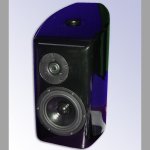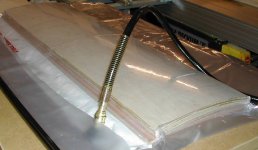"The curved walls will be really stiff. I bet that two layers (i'd use plywood) of 4 mm bonded together with a west-style epoxy and additional layers of epoxy inside and out bent over an irregualr plywood skeleton will outperform the thick lead damped box you are proposing (and you might actually be able to lift it)."
this was a comment make by Planet 10 in a thread a few years back.
I've been thinking of ways to make a cabinet with a shape resembling a fat aircraft wing and the method he explains here seems like it would do the trick. I never thought of using very thin plywood because I was stuck in the mode of thinking that thick and heavy = good. I would not have tried the type of material that planet 10 mentions but his endorsement is enough to make it worth looking at.
Assuming the cabinet is very well braced does this seem like a suitable method of building a cabinet. Im planning a small speaker, either a MT or MTM so the panels will not be large.
Here's the original thread if anyone wants to see it in context.
link
this was a comment make by Planet 10 in a thread a few years back.
I've been thinking of ways to make a cabinet with a shape resembling a fat aircraft wing and the method he explains here seems like it would do the trick. I never thought of using very thin plywood because I was stuck in the mode of thinking that thick and heavy = good. I would not have tried the type of material that planet 10 mentions but his endorsement is enough to make it worth looking at.
Assuming the cabinet is very well braced does this seem like a suitable method of building a cabinet. Im planning a small speaker, either a MT or MTM so the panels will not be large.
Here's the original thread if anyone wants to see it in context.
link
Well, during the construction of my last pair of speakers, which use 5 layers of 4mm plywood over a rigid framework, i tested the speakers out with 2 layers to see what they sounded like, just because the boxes were totally covered with wood. There was a very strong resonance at about 700hz that made some tracks unlistenable. The sound was generally a bit loose and boomy, and i wasnt very impressed. From what i heard id say that 2 layers of 4mm ply simply arnt enough.
Certainly, once id got all 5 layers on the sound improved beyond all recognition and the cabinets became much more inert.
However, these cabinets were glued together with vast amounts of ordinary PVA white glue, I can imagine the adhesive has a major effect on how the layers interact with each other, so using an epoxy may have sonic benefits.
The (nearly) finished article- still need polishing and waxing
(weird reflection on front corner is my fone on the table, not a big dent!)
Certainly, once id got all 5 layers on the sound improved beyond all recognition and the cabinets became much more inert.
However, these cabinets were glued together with vast amounts of ordinary PVA white glue, I can imagine the adhesive has a major effect on how the layers interact with each other, so using an epoxy may have sonic benefits.
The (nearly) finished article- still need polishing and waxing
(weird reflection on front corner is my fone on the table, not a big dent!)
Attachments
lufbramatt said:a rigid framework,
What did the framework look like?
West system epoxy is often used with really thin cedar... basically the cedar is there to act as a "holder" for the epoxy.
dave
2 x 4mm ply is good you just need somthing separating them
Hi,
I'm just building a small pair of 2way active speakers and they are using 2 layers of 4mm ply, the slight twist being there is a layer of 15mm liear pvc foam sandwiched in between
The advantage off the ply/foam/ply is that the resulting panel is very nearly as stiff as a solid wood panel of the same thickness, but less than half the weight, the result is that the fundamental resonance is almost doubled If you want to go a little more high tec you can throw some carbon cloth into the laminate stack
If you want to go a little more high tec you can throw some carbon cloth into the laminate stack
This is fairly standard boatbuildind technology, which is my industry. The laminate can be made into curved panels very easily as the foam can be molded with the use of a hot air gun.
This really is the DIY equivalent to the old celestion SL6i's (or SL600s?) which had cabinets made of Aerolam, to achieve the same high stiffness, low weight properties
regards
nick
Hi,
I'm just building a small pair of 2way active speakers and they are using 2 layers of 4mm ply, the slight twist being there is a layer of 15mm liear pvc foam sandwiched in between
The advantage off the ply/foam/ply is that the resulting panel is very nearly as stiff as a solid wood panel of the same thickness, but less than half the weight, the result is that the fundamental resonance is almost doubled
This is fairly standard boatbuildind technology, which is my industry. The laminate can be made into curved panels very easily as the foam can be molded with the use of a hot air gun.
This really is the DIY equivalent to the old celestion SL6i's (or SL600s?) which had cabinets made of Aerolam, to achieve the same high stiffness, low weight properties
regards
nick
"Obviously, if monocoque construction can handle the vibrational stress of supersonic/space craft, it will work quite well for an audio speaker."
Planes are designed for strength, not sound quality of their airfoils.
Re curved panels, a lot depends on the curvature, more (smaller radius) gives greater stiffness.
Planes are designed for strength, not sound quality of their airfoils.
Re curved panels, a lot depends on the curvature, more (smaller radius) gives greater stiffness.
Greets!
Actually, this isn't true per se since if they're not 'tuned' properly they will either self destruct over time due to vibrational fatigue or shatter rather abruptly from various high stresses, though I was thinking about fuselage construction when I posted this. Regardless, with greater stiffness through high Fs materials and bracing there's less need for damping since acoustic energy falls at 1/f and the stiffer the work 'platform', the greater the electro-mechanical efficiency of the driver(s), up to a point of diminishing returns of course. The wood in between the epoxy 'shell' described in the original post adds a relatively small amount of stiffness and mostly damping, further reducing the need for any add on damping.
Bottom line, the ideal for either is to have no 'sound' quality, i.e. it's mechanical attributes fall outside the desired performance 'window', either above or below, and for wide BW apps such as speaker cabs or planes capable of breaking the sound barrier, etc., 'above' is the most cost effective.
Planes are designed for strength, not sound quality of their airfoils.
Actually, this isn't true per se since if they're not 'tuned' properly they will either self destruct over time due to vibrational fatigue or shatter rather abruptly from various high stresses, though I was thinking about fuselage construction when I posted this. Regardless, with greater stiffness through high Fs materials and bracing there's less need for damping since acoustic energy falls at 1/f and the stiffer the work 'platform', the greater the electro-mechanical efficiency of the driver(s), up to a point of diminishing returns of course. The wood in between the epoxy 'shell' described in the original post adds a relatively small amount of stiffness and mostly damping, further reducing the need for any add on damping.
Bottom line, the ideal for either is to have no 'sound' quality, i.e. it's mechanical attributes fall outside the desired performance 'window', either above or below, and for wide BW apps such as speaker cabs or planes capable of breaking the sound barrier, etc., 'above' is the most cost effective.
There are two basic ways of building the cabinet, first build the internal frame work and apply successive thin sheets of mdf or ply to build up the the laminate thickness needed.
The second way is to laminate the curved sides up first and the build the rest of the speaker inside them, I gave some pictures of this process in thread 30855 on a previous pair of speakers.
The attached image is of one of the side panels for my new pair of speakers being laminated up in a vaccum bag. Panel is 4 layers of 4 mm birch ply.
The second way is to laminate the curved sides up first and the build the rest of the speaker inside them, I gave some pictures of this process in thread 30855 on a previous pair of speakers.
The attached image is of one of the side panels for my new pair of speakers being laminated up in a vaccum bag. Panel is 4 layers of 4 mm birch ply.
Attachments
Yellow Pages lists 3 suppliers of plywood and veneer in Wellington. City Timbers, Thorndon seem most likely as they had boat building stuff. Otherwise try Nichols and Maher Seaview.
IPL Plywood is also listed, don't know them.
Scott Commercial used to be good, if expensive,but I think they have gone to Auckland now.
IPL Plywood is also listed, don't know them.
Scott Commercial used to be good, if expensive,but I think they have gone to Auckland now.
- Status
- This old topic is closed. If you want to reopen this topic, contact a moderator using the "Report Post" button.
- Home
- Loudspeakers
- Multi-Way
- thin curved and braced plywood for cabinets

